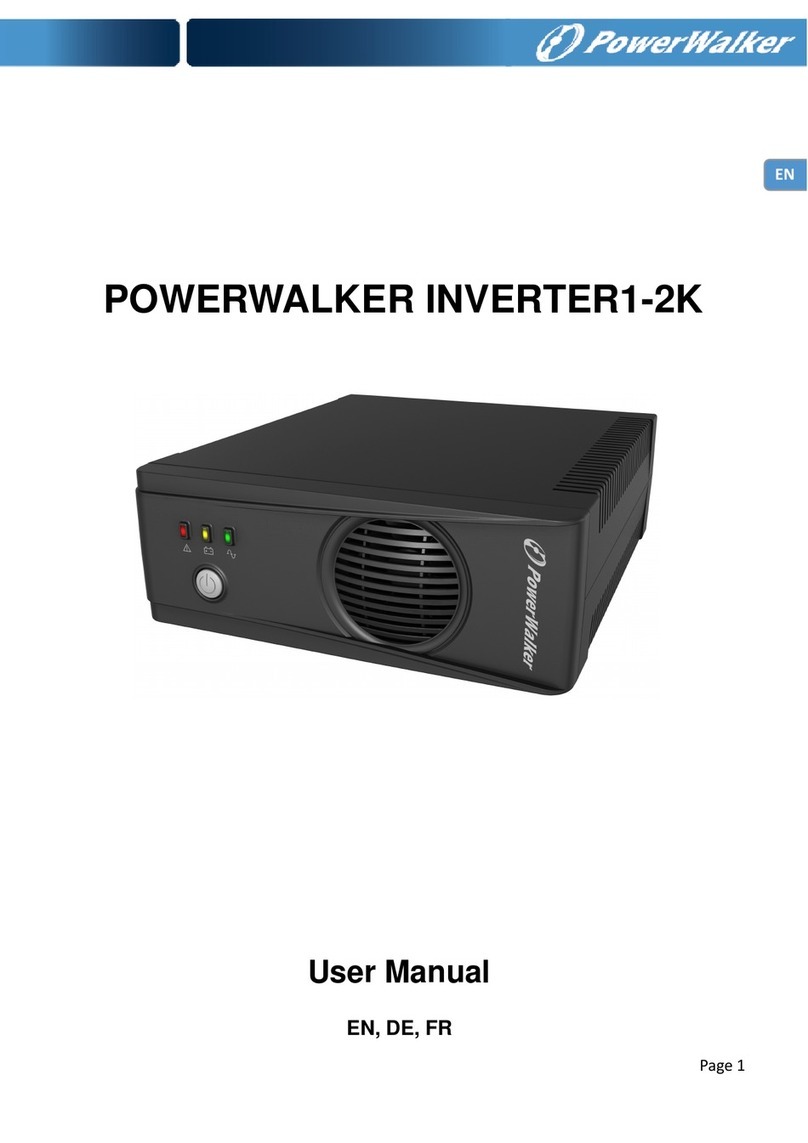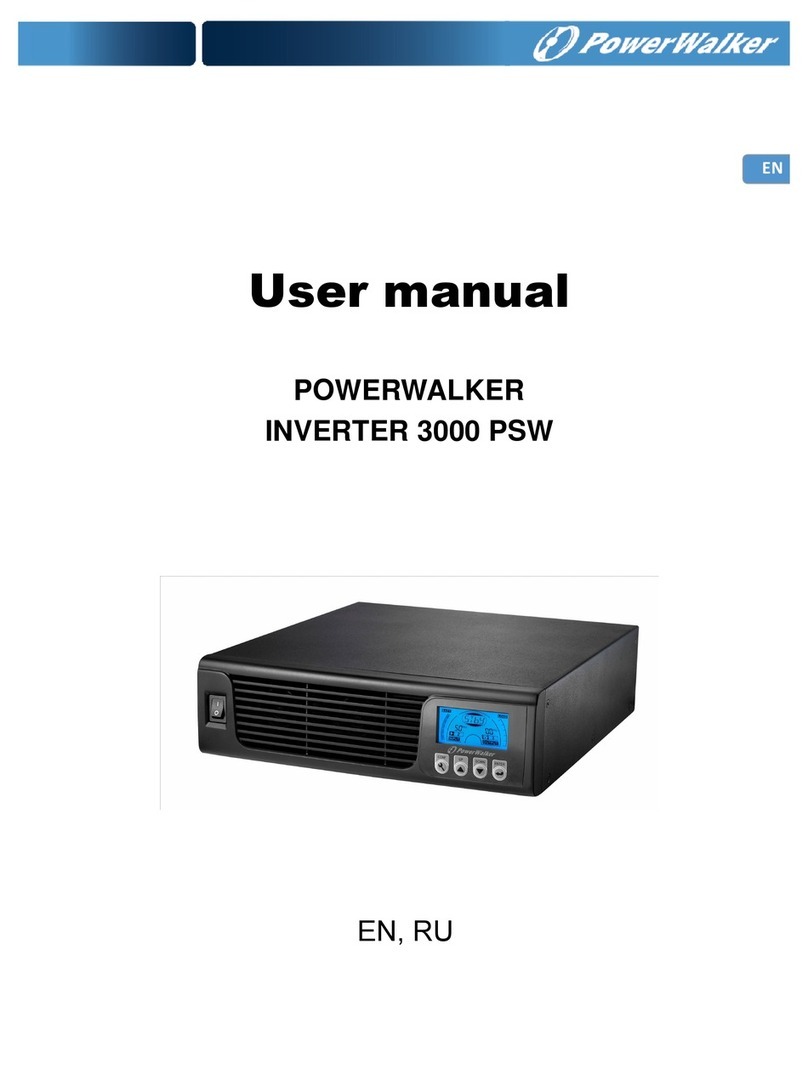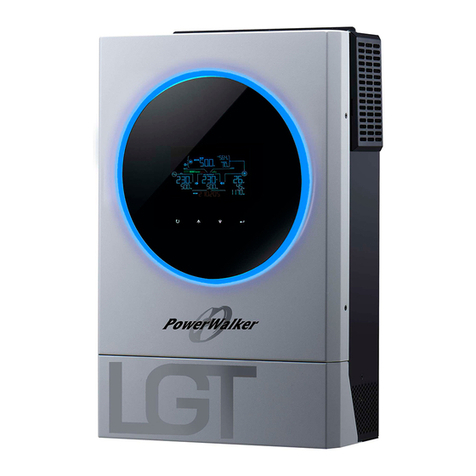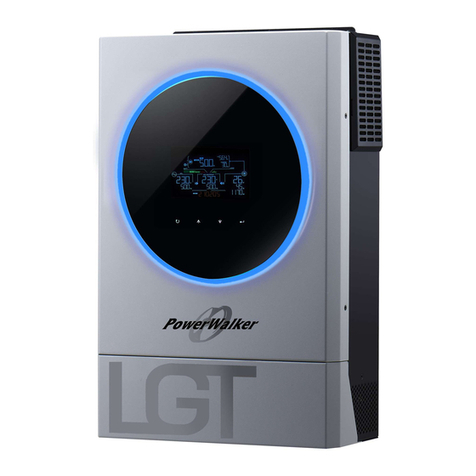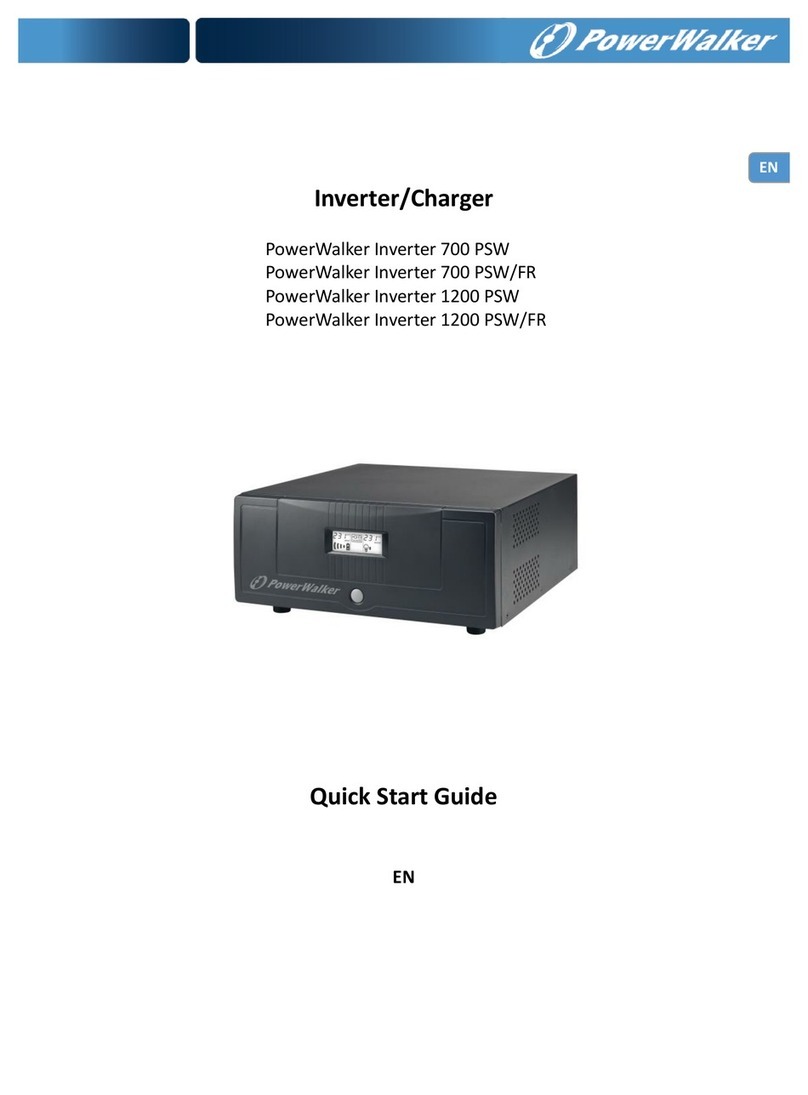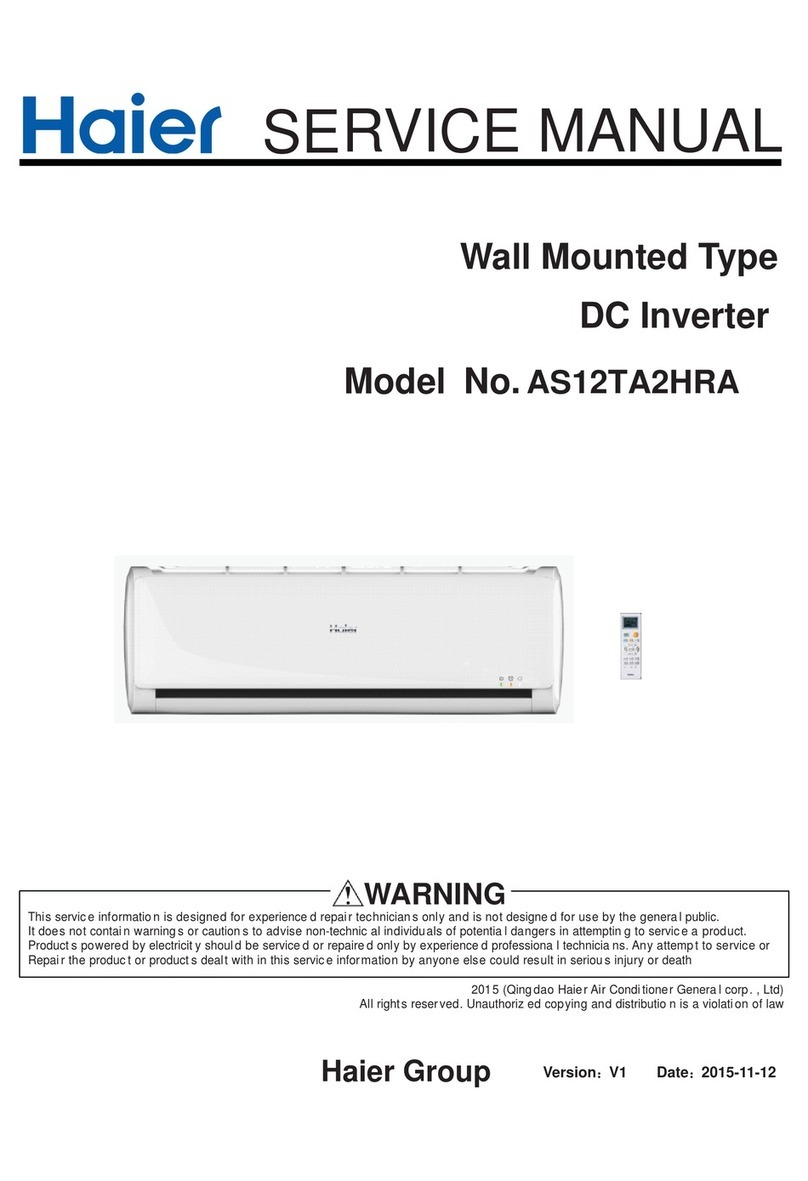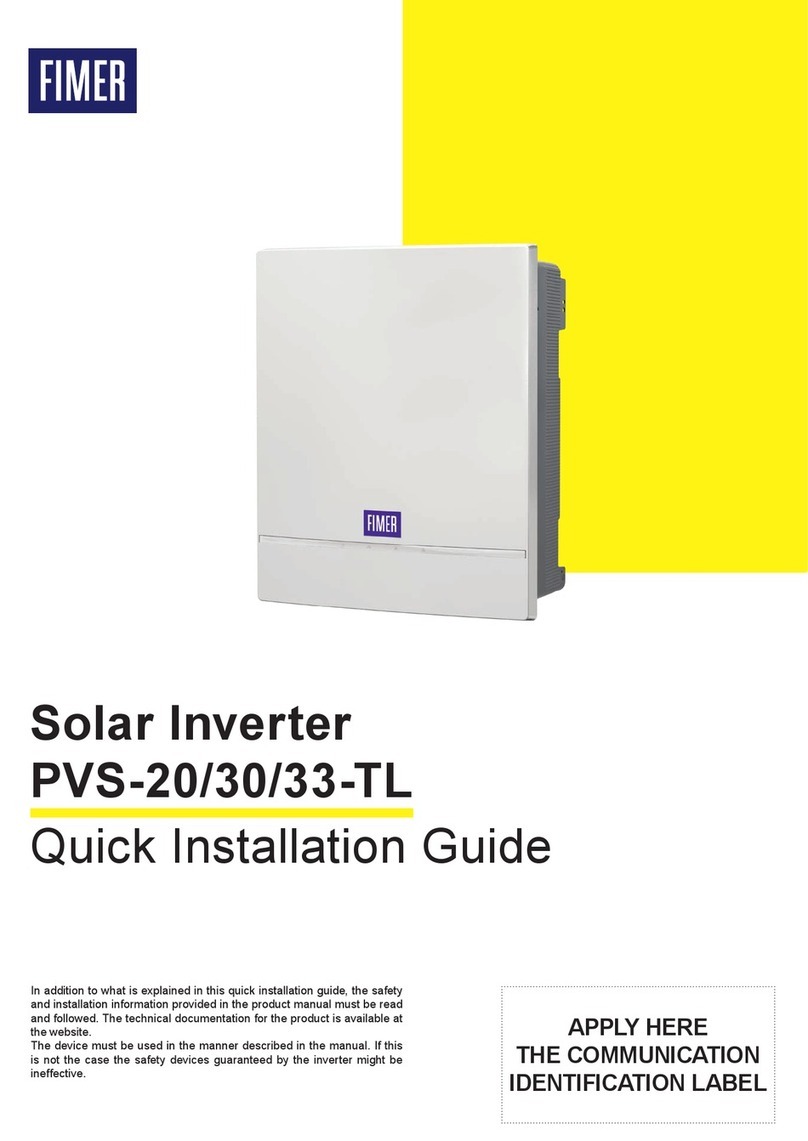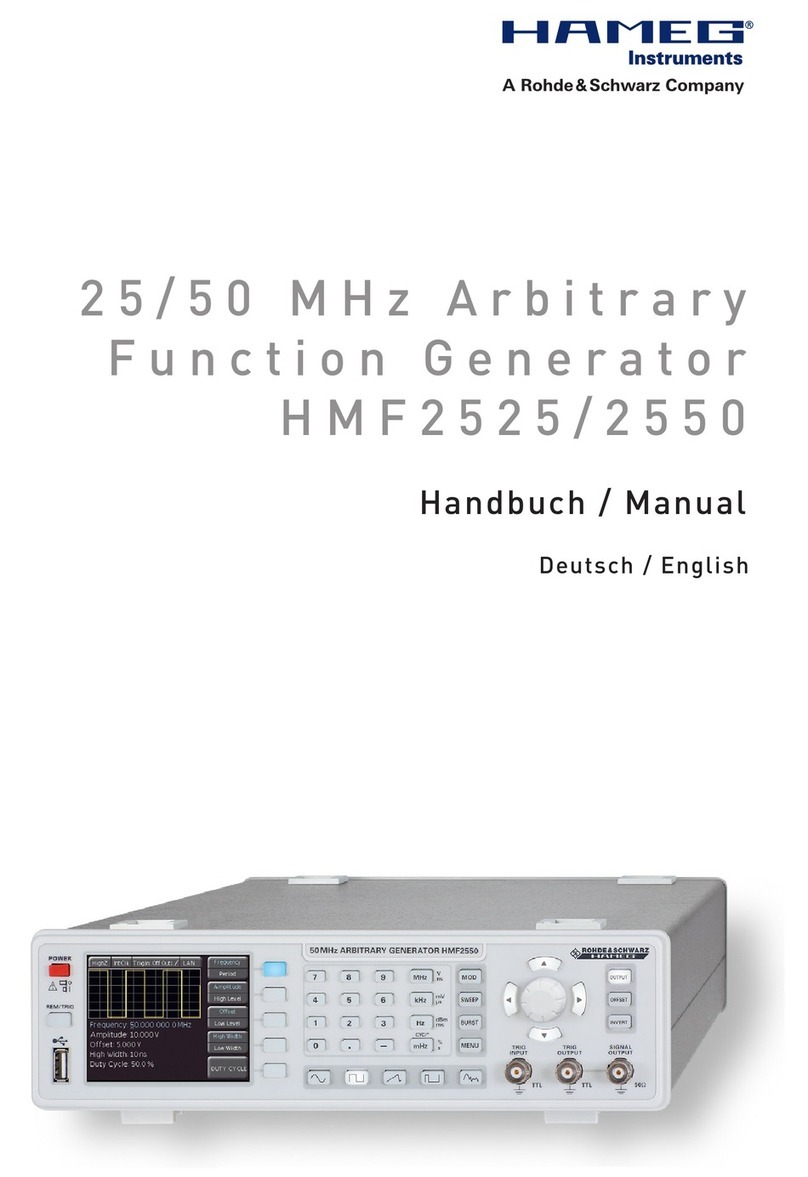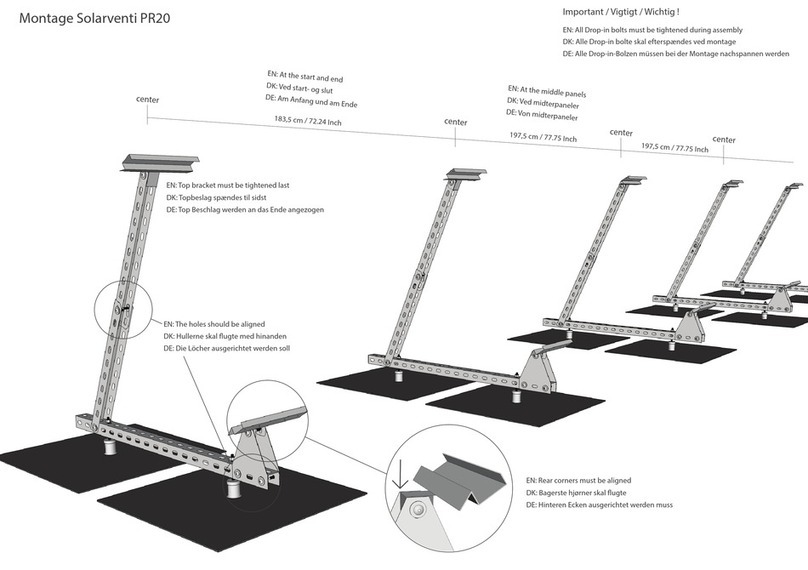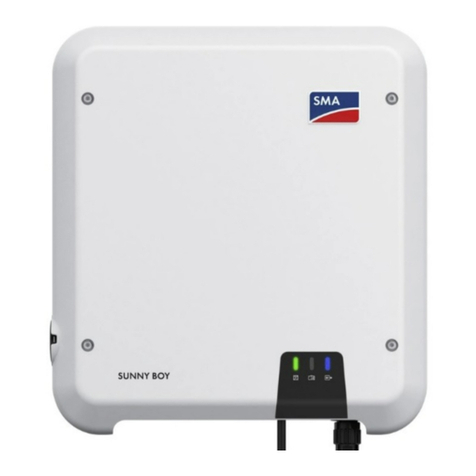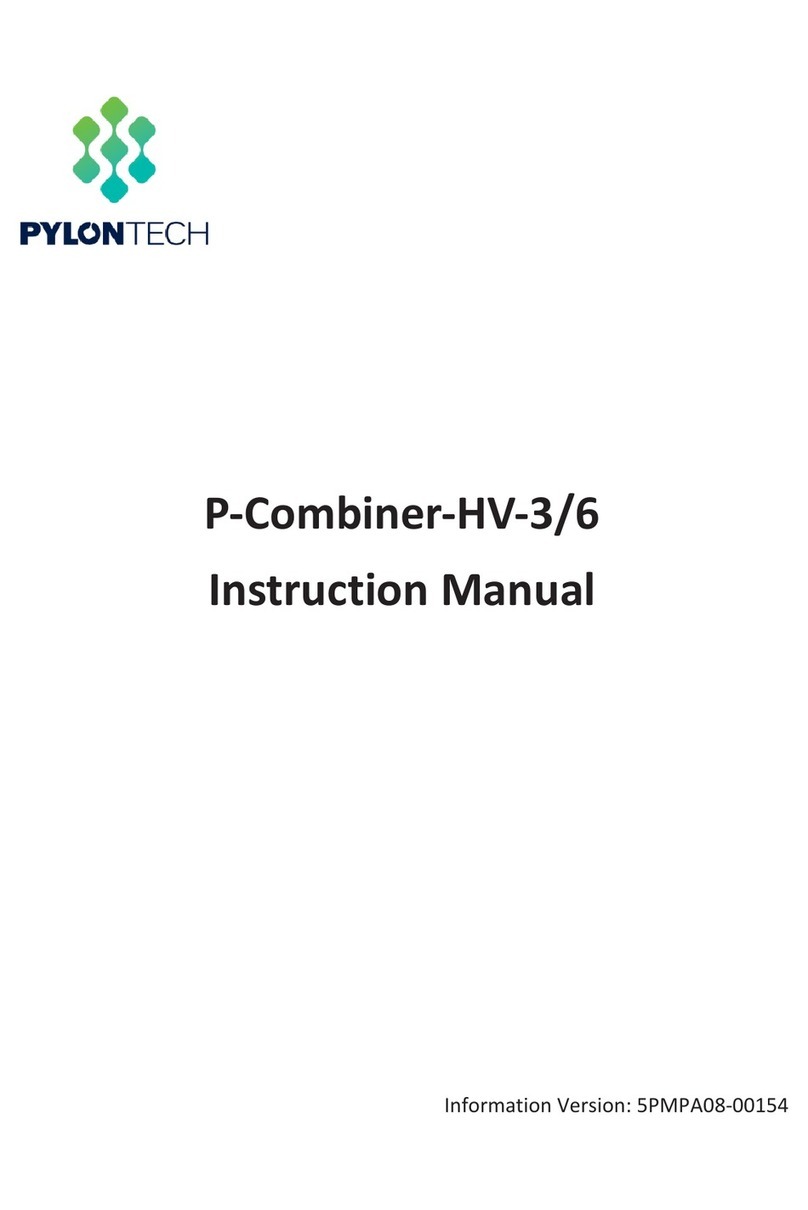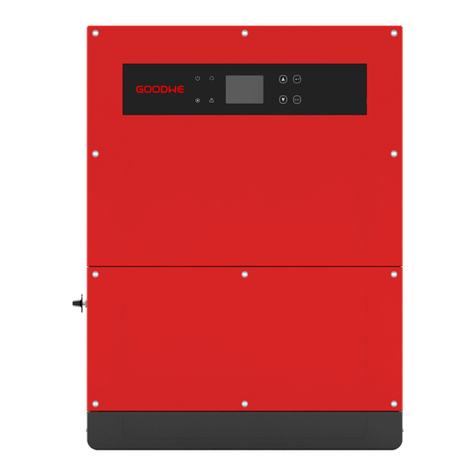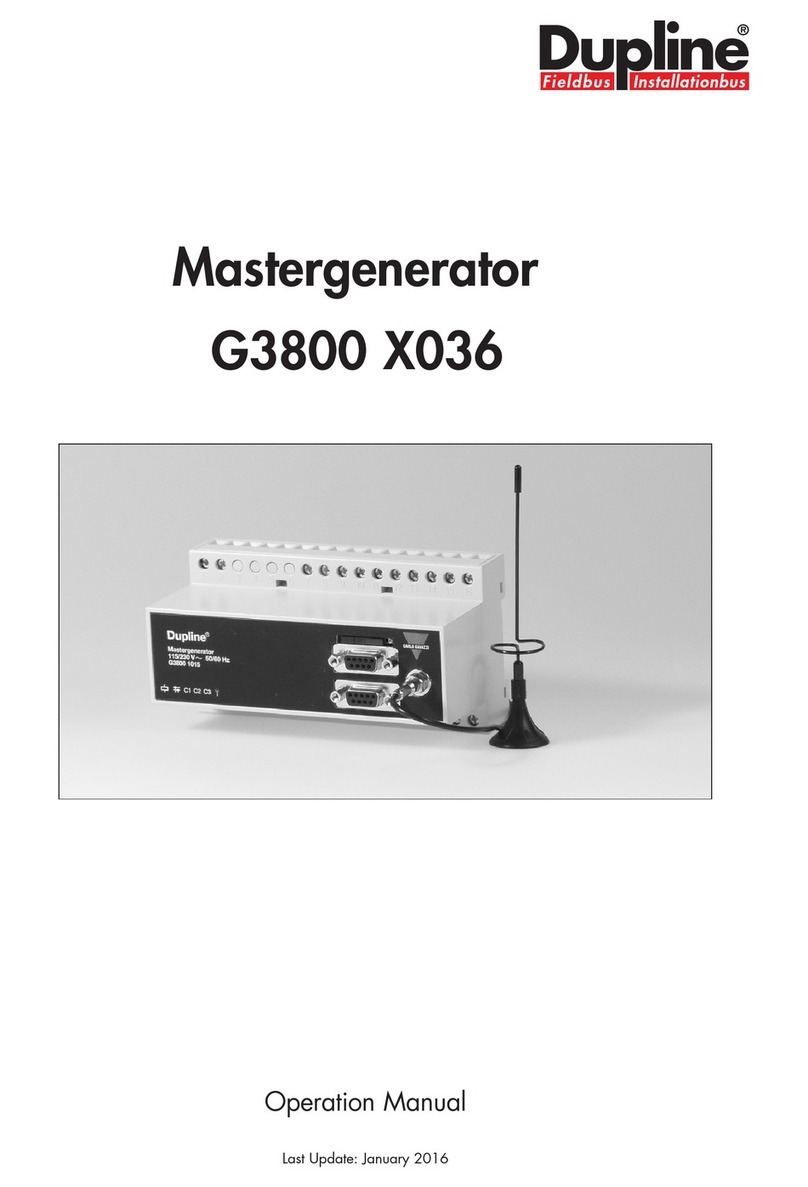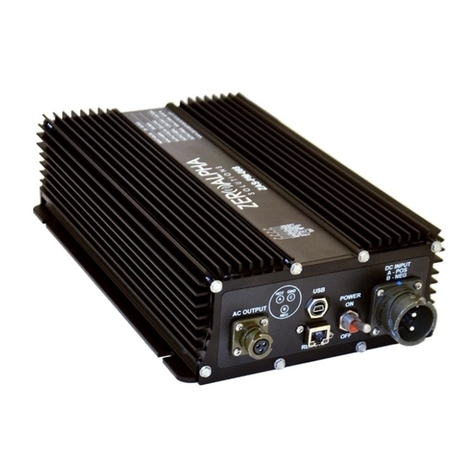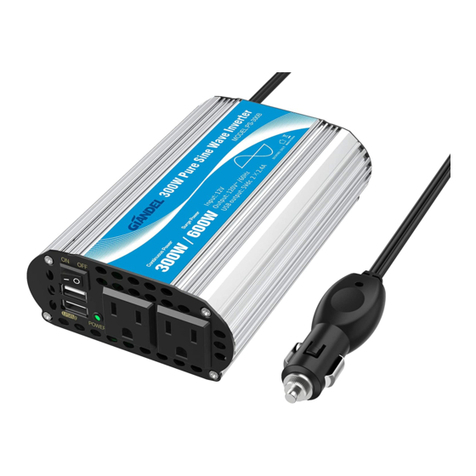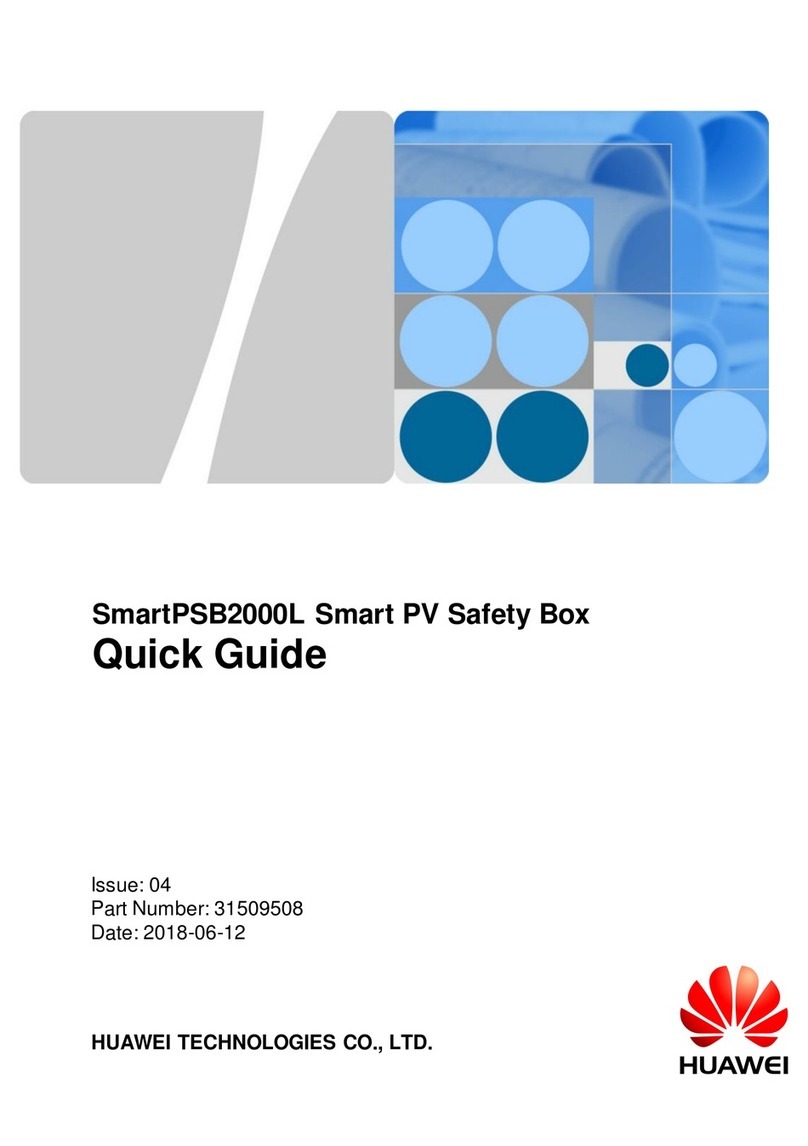PowerWalker 650 SW User manual

Inverter SW Series
User Manual
IMPORTANT SAFETY INFORMATION
(SAVE THESE INSTRUCTIONS)
This manual contains important safety instructions. Please read and follow all instructions carefully
during installation and operation of the unit. Read this manual thoroughly before attempting to unpack,
install, or operate the unit
Insure the wall outlet and inverter are located near the equipment being attached for proper accessibility.
To reduce risk of damage and injury, please use batteries with good quality.
Provide adequate ventilation for the battery compartment. The battery enclosure should be designed to
prevent accumulation and concentration of hydrogen gas at the top of the compartment.
DO NOT expose the unit to rain, snow or liquids of any type. The unit is designed for indoor use only.
DO NOT obstruct the ventilation openings.
DO NOT connect neutral of the power distribution box on the wall to the output neutral of Inverter.
Otherwise the reversed polarity will damage the Inverter and the connected equipment.
CAUTION!Risk of electric shock, do not remove cover. No user serviceable parts inside.
The battery can energize hazardous live parts inside even when the AC input power is disconnected.
To avoid electrical shock, turn off the Inverter and unplug it from theAC power source before servicing
the battery. Servicing the battery can only be performed by trained personnel.
INSTALLING YOUR Inverter SYSTEM
UNPACKING
Inspect the unit upon receipt. The box should contain the following:
Inverter1; User Manual1; Power cord1
HOW TO DETERMINE THE POWER REQUIREMENTS OF YOUR EQUIPMENT
1. Insure that the equipment plugged into the AC outlet does not exceed the Inverter unit’s rated
capacity (refer to TECHNICAL SPECIFICATIONS ). If rated unit capacities are exceeded, an
overload condition may occur and cause the Inverter unit to shut down or the circuit fuse burn down.
2. If the power requirements of your equipment are listed in units other than Volt-Amps (VA), convert
Watts (W) or Amps (A) into VA by doing the calculations below. Note: The below equation only
calculates the maximum amount of VA that the equipment can use, not what is typically used by the
equipment at any one time. Users should expect usage requirements to be approximately 60% of
below value.
HARDWARE INSTALLATION GUIDE
Before installation, please read and understand the following instructions:
1. Placement
The Inverter must be installed in a protected environment away from heat- emitting appliances
such as a radiator or heat register. Do not install this product where excessive moisture is present.
2. Ventilation
The location should provide adequate air flow around the Inverter with 10 CM minimum clearance
on all sides for proper ventilation.
3. Connect the Battery
Connect the external battery pack with the DC cables from the back of the Inverter. Follow battery
polarity guide located near battery cables as below.
“+” Red cable for battery positive polarity;
“-” Black cable for battery negative polarity.
4. Connect to AC and Charge the Battery
Connect the Inverter to a wall outlet. Avoid using extension cords and adapter plugs. Charging the
battery for at least 8 hours is recommended to insure that the battery is fully charged. To recharge
the battery, simply leave the unit plugged into a wall outlet. To maintain optimal battery charge,
leave the Inverter plugged into an AC outlet at all times.
This Inverter can be charged even when Inverter is not turned on.
5. Connect the Load
Connect the equipment to the Inverter outlet. Please make sure that the total loads of your
equipments are less than the maximum total power load of the Inverter.
BASIC OPERATION
DESCRIPTION
1. Power Switch
Press the power switch to turn the Inverter ON or OFF.
2. AC Mode LED
The green LED will light when utility power is normal.
3. Battery Mode LED
The yellow LED will light when power mains are abnormal and the unit will work in battery mode.
4. Fault LED
The red LED will light when fault or over load occurs.
5. AC outlet**
The unit provides one outlet for connected equipment to insure temporary uninterrupted operation
during a power failure and against surges and spikes.
**Note: 2 outlet types available, including Schuko and FR, type.
6. AC Inlet
Connect to utility power through the input power cord.
7. Input Voltage Range Selector
Input voltage range is defined in specification section. Output voltage is the same as input voltage
in AC mode.
A. Select “Narrow” setting for general electrical appliance such as TUBE LIGHT, ENERGY
SAVING LAMP, TV, JUICER & MIXER etc. It is not suitable for high-power motor or inductive
load, such as the fridge of 1KW, the motor of 800W, AIR COOLER(having risk of rebooting)
and so on. In this mode, the Inverter operating voltage in AC mode is within 190~260Vac with
the same output voltage. The line sensitivity is higher.
B. Select “Wide”setting to save energy. In this mode the operating range of voltage for the
Inverter is 100-290Vac. Therefore the output voltage will be the same as the MAINS input
voltage. The Inverter unit in this mode has a lower sensitivity with a longer transfer time for
switching from AC mode to battery mode in the event of power failure. You can safely connect
and use home appliances which are not sensitive to transfer time limitations such as florescent
tubes, bulbs, TV etc.
8. DC Input Cable (Red)
Connect to battery positive polarity.
9. DC Input Cable (Black)
Connect to battery negative polarity.
Functional Test
AC Mode
The Inverter delivers power to the load derived from the utility and maintains proper battery charge.
On-Battery Mode
The Inverter operates on battery when the utility voltage has fallen outside the limits. Local users are
alerted to this mode of operation by visual and audible indicators. The Inverter provides power to the
load from the battery and the output voltage of the Inverter are regulated within a narrow range
1. Switch On
Press the power switch then the status LED will light up.
2. Switch Off
Press again the power switch, the status LED will go off.
3. Cold Start / Start on Battery:
This Inverter can be turned on even when AC is not present.
Press the power switch then the status LED will light up.
ROUTINE MAINTENANCE AND STORAGE
ROUTINE MAINTENANCE
1. Use dry soft clothes to clean the panel and plastic parts. Do not use any detergent that contains
alcoholic ingredient.

2. Unplug the Inverter from power inlet if the Inverter will not operate for long period of time.
STORAGE
1. First turn off your Inverter and disconnect its power cord from the wall outlet. Disconnect all cables
connected the Inverter to avoid battery drain.
2. The Inverter should be stored in a cool dry location.
3. Make sure the battery is fully charged before the Inverter is stored.
4. For extended storage in moderate climates, the battery should be charged for 12 hours every 3
months by plugging the power cord into the wall receptacle and turning on the main switch. Repeat
it every 2 months in high temperature locations.
DEFINITIONS FOR INDICATORS
Condition Fault
Battery Mode
AC Mode
Alarm
Normal Mode/ Off
charge mode
(Battery is fully
charged)
Off Off On Off
Normal Mode
(Battery is charging) Off Off Normally On but
blink every 5
seconds
Off
Battery Mode
(above low battery
voltage)
Off Normally On but
blink every 30
seconds
Off Beeps every 30
seconds
Battery Mode
(under low battery
voltage)
Off Normally On but
blink every 2
seconds
Off Beeps every 2
seconds
Off charge mode
(Auto bypass) Off Off Normally On but
blink every 5
seconds
Off
Fault On Off Off On
Fault(Temperature
fail)
On Off Off On
Fault(Fan fail)
On
Off Off On
Overload Normally On but
blink every 2
seconds
Off Off Beeps every 0.5
seconds
TROUBLE SHOOTING
Problem Possible Causes Remedy
No LED display
1. Battery Weak
1. Re-charge battery
2. Battery defective
2. Battery replacement.
3. Power switch is not
pressed 3. Press and hold power switch.
Mains normal but not works in
AC mode
1. AC Input missing 1. Check AC input connection.
2. Input Fuse is blown 2. Unplug the power cord of the
Inverter then replace the blown
fuse
Alarm buzzer beeps
continuously Overload Verify that the load matches the
capability specified in the specs.
Backup time is shortened
Overload
Remove some non-critical load.
Battery voltage is too low. Charge battery for 8 hours or more.
If any abnormal situations occur that are not listed above, please contact service personnel.
TECHNICAL SPECIFICATIONS
Model
PowerWalker Inverter 650 SW
Capacity (VA)
650
Capacity (Watts)
325
Input
Input Voltage
Range
Wide mode: 100VAC-280VAC
Narrow mode: 190VAC-260VAC
Frequency Range
50/60Hz
Output
On Battery Output
Voltage
Sine Wave at 230Vac +/-10%
On Battery Output
Frequency
50/60Hz
Overload
Protection
On Utility: fuse On Battery: Internal Current Limiting
Physical
Total # of Inverter
Receptacles
(1) Type E or Type F
Maximum
Dimensions
(HxWxD) (mm)
115x205x146
Weight (Kg.)
4.0
Battery
Lead Acid Battery
12VDC
Warning Diagnostics
Indicators
AC Mode, Power On, Battery mode, Fault
AudibleAlarms
Low Battery, Overload, Fault
Environmental
Operating
Temperature
0°C to 40°C
Operating Relative
Humidity
0 to 95% NON-CONDENSING
Management
Auto-Charger
Yes
Auto-Restart
Yes

Seria Inverter SW
Instrukcja Obsługi
WAŻNE INSTRUKCJE BEZPIECZEŃSTWA
(ZACHOWAJ TĄ INSTRUKCJĘ)
Ta instrukcja zawiera ważne wskazówki dotyczące bezpieczeństwa. Proszę przeczytać i dokładnie
przestrzegać wszystkich uwag podczas instalacji i użytkowania urządzenia. Przeczytaj tą instruckję
przed odpakowaniem urządzenia.
Podłączając urządzenie do kontaktu zapewnij dobry dostęp. Aby zredukować ryzyko uszkodzeń używaj
tylko baterii dobrej jakości. Upewnij się, że otwory wentylacyjne nie są zakryte. Moduł bateryjny
powinien mieć dobra wentylację, a obudowa nie powinna doprowadzać do akumulacji gazów w jego
górnej części.
Aby uniknąć ryzyka pożaru lub porażenia prądem, należy urządzenie zainstalować w pomieszczeniu z
kontrolowaną wilgotnością i temperaturą wewnątrz budynku. Aby uniknąć ryzyka przegrzenia
urządzenia, nie należy przykrywać otworów wentylacyjnych, użytkować urządzenia w pełnym słońcu ani
przy urządzeniach emitujących ciepło (jak np. grzejniki)
Nie podłączaj przewodu neutralnego z wejścia do wyjścia inwertera (tzw. Neutral bypass). Taka
czynności doprowadzi do uszkodzenia urządzenia.
UWAGA!Ryzyko porażenia prądem. Nie otwieraj obudowy urządzenia.
Bateria może zasilać element y urządzenia nawet gdy napięcie sieci jest odłączone.Wymiana baterii
powinna być wykonywana przez osobę do tego przeszkoloną.
INSTALACJA INWERTERA
ROZPAKOWYWANIE
Sprawdź opakowanie przy zakupie. W środku powinny się znajdować:
Inwerter1; Instrukcja1; Kabel zasilający1
WYZNACZ CAŁKOWITE OBCIĄŻENIE
1. Upewnij się, że całkowite obciążenie podłączone do Inwertera (watt) nie przekracza dopuszczalnego
obciążenia (zobacz SPECYFIKACJA TECHNICZNA). W przypadku przekroczenia dopuszczalnej
mocy Inwerter wyłączy się lub zadziała bezpiecznik.
2. Jeśli całkowita moc urządzeń podłączonych do UPSa nie jest wyrażona w Voltoamperach (VA),
przelicz moc w Watach dzieląc przez 0.6 (współczynnik mocy inwertera)..
PODŁĄCZENIE URZĄDZENIA
Przeczytaj I zastosuj się do poniższych uwag przez przystąpieniem do instalacji:
1. Umiejscowienie
Inwerter musi być umiejscowiony w bezpiecznej odległości od urządzeń grzewczych. Środowisko
pracy musi miec kontrolowaną temperature I wilgotność.
2. Wentylacja
Zapewnij minimum 10cm przestrzeni do okoła urządzenia dla odpowiedniego przepływu powietrza.
3. Podłącz Baterię
Podłącz zewnętrznę baterię używając
kabla prądu stałego z tyłu inwertera.
Upewnij się, że polaryzacja jest właściwa.
“+” Czerwony kabel oznacza pozytywną
polaryzację
“-“ Czarny kabel oznacza negatywna
polaryzację
4. Podłącz do zasilania I naładuj baterię
Podłącz inwerter to gniazda zasilającego. Unikaj używania przedłużaczy i adapterów. Ładuj baterię
minimum 8h aby zapewnić jej pełną wydajność. Bateria będzie ładowana, jeśli urządzenie jest
podłączone do sieci. Rekomendujemy pozostawienie urządzenia podłączonego do sieci
permanentnie.
Inwerter ładuje baterie nawet gdy jest wyłączony.
5. Podłącz urządzenie
Podłącz urządzenia do wyjścia inwertera. Upewnij się, że nie spowodują przekroczenia
maksymalnego dopuszczalnego obciążenia.
PODSTAWOWE OPERACJE
OPIS
1. Przycisk on/off
Naciśnij przycisk aby wyłączyć/włączyc inwerter.
2. LED trybu AC
Zielona LED świeci się gdy parametry pracy wejścia I wyjścia sa normalne.
3. LE trybu baterii
Żółta LED świeci się gdy brak zasilana wejściowe, a inwerter pracuje z zasilania baterii
4. Błąd LED
Czerwona LED świeci sie w przypadku błędu urządzenia lub przeciążenia.
5. Gniazdo wyjścia**
Urządzenie posiada gniazdo do podłączenia odbiorników, które mają być chronione przez inwerter
podczas awarii seici.
**Ważne: 2 typy wyjść są dostępne,Typ E (używane w Polsce) oraz F.
6. Gniazdo wejścia
Podłącz inwerter do sieci używając tego gniazda.
7. Przełącznik zakresu napięcia wejściowegor
Zakres napięcia wejściowego jest opisana w specyfikacji technicznej. Napięcie wyjściowe jest
takie same jak napięcie wejściowe w trybie AC.
A. Wybierz “Narrow” (wąski zakres) dla typowych zastosowań domowych. Nie stosuj tego trybu
dla motorów o wysokiej mocy ani odbiorników indukcyjnych jak duża lodówka, klimatyzacja itp.
B. Wybierz “Wide”(szeroki zakres) aby oszczędzać baterię. W tym trybie inwerter będzie
przełączał na tryb baterii tylko w przypadku bardzo niskiego napięcia lub jego braku. Napięcie
wyjścia będzie takie same jak napięcie wejścia nawet przy 100 voltach. Takie ustawienie jest
wystarczające dla żarówek bądź urządzeń IT z adapterami, które akceptują napięcie 100-250V.
8. Zacisk baterii (czerwony)
Podłącz dodatni terminal baterii.
9. Zacisk baterii (czarny)
Podłącz ujemny terminal baterii.
Funkcjonalność
Tryb AC
Inwerter dostarcza moc odbiornikom korzystając z napięcia sieci I ładuje baterię.
Tryb Baterii
Inwerter zasila odbiorniki korzystając z energii zgromadzonej w baterii gdy napięcie wejściowe jest poza
zakresem. Inwerter powiadomi o tym trybie przez sygnał dźwiękowy i świetlny.
1. Włącz
Naciśnij przycisk on/off a dioda zapali się.
2. Wyłącz
Naciśnij przycisk on/off a diode zgaśnie.
3. Cold Start / Włączenie do trybu baterii bez napięca sieci:
Inwerter może zostać włączony bez napięcia sieci korzystając z energii baterii. Naciśnij przycisk
on/off a diode zapali się.
UTRZYMANIE I PRZECHOWYWANIE
UTRZYMANIE
1. Używaj suchej szmatk aby wyczyścić przedni panel I części plastikowe. Nie używaj żadnych
detergentów na alkoholu.
2. Odlącz inwerter od zasilania jeśli nie planujesz go używać przed dłuższy czas.
PRZECHOWYWANIE
1. Najpierw wyłącz inwerter, odłącz odbiorniki I zasilanie.
2. Przechowuj urządzenie w suchym I chłodnym miejscu.
3. Upewnij się, że bateria jest naładowana do pełna przed magazynowaniem.

4. W przypadku długiego składowania urządzenia w umiarkowanym klimacie, bateria powinna być
doładowana przez 12 godzin co 3 miesiące (poprzed podłączenie jej do inwertera). W przypadku
bardziej surowego klimatu doładuj baterię co 2 miesjące.
OPIS SYGNALIZACJI AUDIOWIZUALNEJ
Warunek Błąd
Tryb Baterii
Tryb AC
Alarm
Tryb Normalny
(Naładowana bateria)
Wył. W ył.
Wł. W ył.
Tryb Normalny (Ładuje
baterie)
Wył.
Wył.
Włączony, mruga
co 5s.
Wył.
Tryb Baterii (Wysoki
Poziom Baterii)
Wył.
Włączony, mruga
co 30s.
Wył.
Dźwięk co 30s.
Tryb Baterii (Niski
Poziom Baterii)
Wył.
Włączony, mruga
co 2s.
Wył.
Dźwięk co 2s.
Ładowanie Baterii Wył.
Wył.
Włączony, mruga
co 5s.
Wył.
Błąd Wł. W ył.
Wył.
Wł.
Błąd (temperature)
Wł.
Wył.
Wył.
Wł.
Błąd (wiatrak)
Wł.
Wył.
Wył.
Wł.
Przeciążenie Włączony, mruga
co 2s.
Wył.
Wył.
Dźwięk co 0.5s.
ROZWIĄZYWANIE PROBLEMÓW
Problem Możliwy Powód Rozwiązanie
Diody się nie święcą
1. Słaba Bateria
1. Naładuj Baterię
2. Uszkodzona Bateria
2. Wymień Baterię
3. Przycisk nie jest
włączony Naciśnij przycisk
Napięcie wejściowe normalne,
ale inwerter nie działa
1. Źle podłączona wtyczka 1. Sprawdź wtyczkę
Przepalony Bezpiecznik 2. Odłącz urządzenie I wymieć
bezpiecznik
Ciągły dźwięk alarmu Przeciążenie Odłącz nadmiarowe odbiorniki
Zbyt krótki czas podtrzymania
na baterii
Przeciążenie
Odłącz część odbiorników
Napięcie baterii jest zbyt
niskie
Naładuj baterię do pełna
W przypadku wyżej nieopisanych sytuacji skontaktuj się z serwisem.
SPECYFIKACJA TECHNICZNA
Model
PowerWalker Inverter 650 SW
Moc (VA)
650
Moc (Watt)
325
Wejście
Zakres Napięcia Szeroki Zakres: 100VAC-280VAC
Wąski Zakres: 190VAC-260VAC
Częstotliwość
50/60Hz
Wyjście
Napięcie w trybie
baterii
Sinusoidalne 230Vac +/-10%
Częstotliwość
50/60Hz
Zabezpieczenie
przed
przeciążeniem
Przy napięciu sieci: bezpiecznik
W trybie baterii: Wewnętrzy stycznik
Dane fizyczne
Gniazda
(1) Typ E lub Typ F
Wymiarys
(WxSxG) (mm)
115x205x146
Waga (Kg.)
4.0
Bateria
Bateria
12VDC kwas ołowiowy
Diagnostyka
LED
Tryb AC, Status Włączony, Tryb Baterii, Błąd
Alarm
Słaba Bateria, Przeciążenie, Błąd
Środowisko
Temperatura Pracy
0°C do 40°C
Wilgotność
0 to 95% bez skraplania
Zarządzanie
Auto-Ładowarka
Tak
Auto-Restart
Tak
This manual suits for next models
1
Table of contents
Languages:
Other PowerWalker Inverter manuals
